Day 01 Paro – Thimphu.
Arrive Paro International Airport
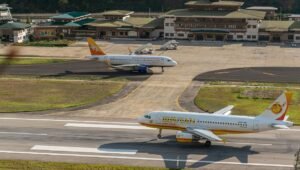
After arriving & visa formalities and collection of baggage, you will be
welcomed by our tour representative who will be your tour guide during
your entire trip in Bhutan. Drive to Thimphu.
Check in Thimphu Hotel.
Day: 02 Thimphu – Thimphu.
Early breakfast you will be visiting Following Places in Thimphu.
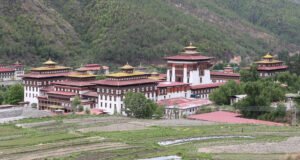
Tashichho Dzong
The Tashichho Dzong is a Buddhist monastery cum fortress at the northernedge of Thimphu the capital city of Bhutan. The Dzong was built on the western bank of the river Wang Chu, and has historically
served at the seat of the DrukDesi or the Dharma Raja of Bhutan‟s government. After the kings assumed power in 1907 this post was combined with that of the king and Thimphu severed as the summer caital of the kingdom before becoming the full time capital of Bhutan.
The original Thimphu Dzong (the Dho-Ngyen Dzong) is said to have been constructed in 1216 by Lama Gyalwa Lhanangpa. And was later taken over by Lama Phajo Drukgom Shigpo before the Dzong was conquered by Shabdrung Ngawang Namgyal, who found the Dzong to
be too small and expanded it to what is now known as theTashichho dzong is also called the “fortress of glorious religion.” It was erected in 1641 and was subsequently rebuilt by King Jigme Dorji Wangchuck in
the 1960s.
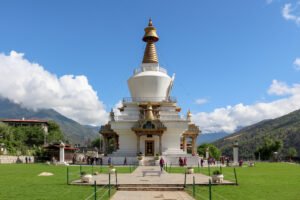
National Memorial Chorten
The National Memorial was built by Bhutan’s third king, H.M. Jigme Dorji Wangchuck who is also known as the “father of modern Bhutan.” He wanted to erect a monument carrying the message of world peace and prosperity. However, he was unable to give shape to his idea in his lifetime due to pressures of state and other regal responsibilities. After his untimely demise in 1972, the Royal Family and Cabinet resolved to fulfill his wishes and erect a memorial that would perpetuate his memory and also serve as a monument to eternal peace, harmony and tranquility.
The National Memorial Chorten was gifted to the nation on 28 July, 1974. The exquisite wall paintings and the delicately carved statues reflect deep insights into Buddhist spirituality and a rich tradition of
prayer and learning. The National Memorial Chorten is known as
the most visible religious landmark in Bhutan‟. The national Memorial Chorten is located in the center of the capital city, Thimphu and is designed like a Tibetan style Chorten. The Chorten is patterned of the classical Stupa design with a pyramidal pillar crowned by a crescent moon and sun. One of the most distinct features of the Chorten is its outwards flaring rounded part that makes the Chorten look more like a vase rather than the classical dome. The interior of the Chorten has a large number of paintings of Tantric deities, in explicit sexual poses that sometimes can be a little disconcerting to visitors.
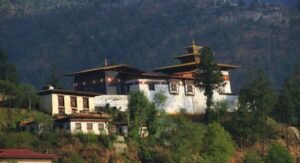
Changangkha lhakhang
The Chagangkha Lhakahng temple is a early medieval Buddhist temple in the capital city Thimphu. The temple is situated on a ridge overlooking the city, near Mohitang on the outskirts of Thimphu. The temple is the oldest temple in Thimphu and was constructed by Lama Phajo Drukgom Zhigpo in the 12 century AD. Lama Phajo Drukgom Zhigpo is also the founder of the Drukpa Kaygo School of Buddhism. The Lhakhang‟s central deity is Chenirizig. There is a large statue of
Chenrizig, the 11 headed, thousand arm manifestation of Avolokiteshwara. The prayer books in the temple are larger in size compared to the usual Buddhist texts. There are also large prayer wheels and paintings in the walls of the temple. The temple offers an excellent view of the city of Thimphu from its courtyard.
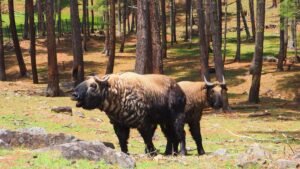
Motithang Takin preserve
The MotithangTakin Preserve also known as the Thimphu Zoo by many is a small natural preserve for the Takin Bhutan’s national animal. It was originally a mini zoo, but it was converted in a preserve later on as the Takin. The mini zoo contained a small number of Takin but the King of Bhutan later decreed that it was improper for a Buddhist nation to keep an animal in captivity. The animals were set free and the zoo was shut down, but for some reason the Takin refused to leave the area for the forests nearby. The preserve is a forested preserve that mimics the Takin‟s natural habitat, in addition to the Takin there are a few musk deer and barking deer that live inside the preserve. There are plans to expand the preserves collection to include other rarely seen animals that live in Bhutan, currently the preserve plans to add the Red Panda and the Himalayan Serow to the preserve.
Over Night in Thimphu Hotel.
Day: 03 Thimphu to Punakha.
After breakfast we will drive towards Punakha via Dochula pass. We will stop over for tea at Dochula (3,100 m), where on a sunny day; you can get stunning views of the Himalayan ranges. The Dochu La Pass is probably the best known mountain pass in Bhutan. Located at an altitude of 3150 meter above sea level, the Dochu La Pass is about 30 kilometer away from the capital city Thimphu and the road to Punakha.
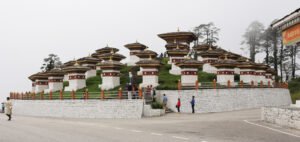
On a clear day the pass offers visitors a spectacular view of the majestic eastern Himalayan Ranges. A cup of hot coffee or tea at the pass has almost become part of tradition for people travelling to and fro from Punakha to the capital city.
There is a small cafeteria at the pass that offers a chance for travelers to enjoy a hot beverage or a snack, it is located just off the road and overlooks the pass and is an ideal place to sit back, relax and enjoy the view. Another striking feature at the pass is the 108 Druk Wangyal Khangzang Chortens, that were built for the well-being of all sentiment beings on earth. The 108 Chorten were built as a tribute to the Kings
of Bhutan for their selfless service and leadership they offer to the people of Bhutan. These Stupas or Chortens also represent the peoples love, appreciation and loyalty towards the country’s King.
Then we will hike towards The Lungchutse Lhakhang. Located above Dochula pass at an altitude of 3,566 meters, the Lungchutse Lhakhang was built by Terton Drukda Dorji towards the end of the 16th century. His Majesty the King, His Majesty the fourth Druk Gyalpo, Their Majesties the Queens, and Their Royal Highnesses the Princes and Princesses attended the consecration ceremony.
From 108 chortens the trail gradually climbs into red, white and pink rhododendron forest with some steep sections before branching left to Lungchutse Monastery. From the pass, drive downhill through the forests of rhododendron, fir and hemlock. Traverse through rice field and driving along the bank of the Punakha River, we arrive at Punakha. On the way, stop at Metshina Village and take a 20-minute walk through the rice fields to Chimi Lhakhang, which is a fertility temple dedicated to the Divine Madman or Lama Drukpa Kuenley. If you wish, receive the blessing from the Lama`s wooden phallus!
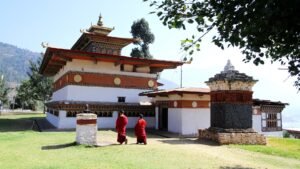
Chimi Lhakhang
The Chimi Lhakang or the Chimel Lhakang is a Bhuddhist monastery located in the Punakha District of Bhutan. The monastery stands on a small hill close to the village of Lobesa and was constructed in 1499 by Ngawang Choegyel, the 14thDrukpaheirarch. The Temple is very deeply connected to the legends of Saint Drukpa Kinley also known as the Devine Madman. It has been said that the demon of Dochu-La with a magic thunderbolt of wisdom in imprisoned him in a rock close to the temple Drukpa Kuenley is called the Divine Madman due to his unorthodox methods of teaching via songs, humor and sometimes bizarre and shocking behavior with deep sexual overtones. You might be shocked to see that the temple houses a number of wooden phalluses that the Lama had brought with him from Tibet. Pilgrims who visit the monastery receive the blessing by being struck on the head with a ten inch wooden Phallus (erect penis). The symbol of an erect penis is said to ward off evil. The monastery is also known as the temple of fertility and is visited not only by the Bhutanese but women from countries as far as Japan and United States to receive a special blessing that can help these women conceive children. These women receive the blessing by getting struck on the head with a 10 inch wooden/ ivory phallus.
The Temple can be accessed by undertaking a short 20 minute walk across the rice fields from the nearest road head. The Lhakhang is a square shaped building with a golden spire on its roof. The temple has many rows of prayer wheels and the temples exterior has embedded slate carvings of various Buddhist saints. Near the temples entrance there is a small Chorten that marks the spot where the Lama subdued the demon of Dochu La.

Punakha Dzong
The Punakha Dzong or the Pungtang Dechen Phortang Dzong is located at the confluence of the Mo Chhu and the Po Chhu River, combine to form the Puna Tsang Chu which in turn is a tributary of the mighty Brahmaputra River. The Dzong was constructed by Sahbdrung Ngwang Namgyal Wangchuck in 1638 on the exact spot as prophesized by the Guru Rinpoche some 800 years ago. According to the prophecy of Guru Rinpoche “a person named Namgyal will arrive at a hill that looks like an elephant”. And lo behold! Shabdung Ngawang Namgyal found that the peak of the hill was in the shape of an elephant‟s trunk and built the Dzong at that very spot. Another legend associated with the Dzong is that of Zowe Palep, the architect of the Dzong received vision of the Dzong in his sleep. This vision got imprinted in the architects mind and enabled him to construct the Dzong without putting his plans to paper.
The Punakha Dzong is the second largest and the second oldest Dzong in Bhutan. The Dzong is home to some of the most sacred relics of the Drukpa Kagyu School of Buddhism; it is also home to the sacred mortal remains of Shabdrung Nagawang Namgyal and Trenton Pema Lingpa the great treasure discoverer of Bhutan. The Punakha Dzong has also served as the capital Bhutan till 1955 before the capital was moved to Thimphu. The Dzong is still the winter residence of the Je Khenpo (chief abbot) and the central monastic body. The Punakha Dzong plays host to the annual Punakha Theschu Festival which is very popular with the locals and tourists alike.
Over Night in Punakha Hotel.
Day: 04 Punakha to Paro
Early breakfast will drive towards Paro and upon reaching Paro you will visit following places after lunch.
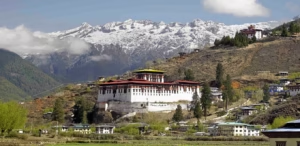
Rimpung Dzong
The Paro Dzong is probably Bhutan’s best known and most iconic Dzong. This is probably the first building you will notice when you land at Paro International Airport and will probably be your first memory of
Bhutan. The imposing Dzong is perhaps the finest example of Dzong architecture existing the world today, the massive buttered walls of the fortress dominates over the valley. The Rinpung Dzong’s names translate to the “Fortress on a heap of Jewels “.
The fortress was constructed in 1644 by Zhabdrung Ngawang Namgyal on the foundations of an ancient monastery. The approach toward the Dzong is through a traditional covered bridge called the Nemi Zam. A paved stone path runs alongside the imposing outer walls of the structure. The valley’s annual springtime religious
festival called the Paro Tsechu is organized each year in the courtyard of the dzong and is attended by tourists from all over the world.

Ta Dzong (National Museum of Bhutan)
The National Museum of Bhutan is housed inside the six storied circular Ta Dzong. The Ta Dzong is a medieval watch tower situated above the Rimpung Dzong. The Ta Dzong was constructed in 1656 with a purpose to give advance warning to the Paro Dzong in case of an approaching army, in fact the word Ta means ‘to see’ in Dzongkha.
The future first king was imprisoned here for a brief period in 1872. In 1968 the Ta Dzong was converted into the National Museum of Bhutan. The Museum houses a priceless collection of textile, costumes, paintings, appliqué, wooden handicrafts, weapons, amour and jewelry. There is a small section dedicated to the natural
history of Bhutan. There is a small chapel on the top of the building with icons representing Himalayan Buddhist traditions.
Later in the evening you will visit local market and then overnight in a hotel in Paro.
Day 05: Tiger Nest.
After early morning breakfast, we will take you for a morning hike up to Taktsang Monastery, also known as „Tiger‟s Nest‟. Hanging precariously and magically from a rather steep cliff, the Taktshang monastery is a monument of genuine pride for the Bhutanese nation. It defies architectural principles to the core and amazes tourists from around the world. It is a sight to behold. Taktshang or the Tigers lair as the monastery is called, it is widely regarded is one of the most important monuments of spiritual significance in Bhutan.
Its history is deeply associated with the visit of Guru Padmasambhava, the revered Indian saint who came to Bhutan in the 8th century AD. The cave was named Taktshang after Guru Rinpoche flew into the cave from Kurtoe Singye Dzong in eastern Bhutan while riding on a tigress.

From the road, the hike toward Taktshang follows an uphill route and takes approximately 3-4 hours at an average walking pace on a clear, sunny day. We recommend that you carry sunscreen lotion, large quantities of drinking water, a walking stick just in case you need to shoo of the birds and a hat to further protect yourself from the sun.
Note: Following places for alternatives other then Tiger Nest.
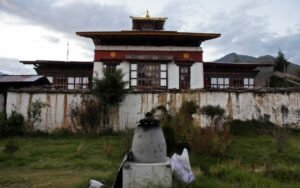
Druk choeding
Druk Choeding is also known as Tshongdoe Naktshang. The temple was built by Ngawang Chhogyel, who was a prince of Ralung and the ancestor of Zhabdrung Ngawang Namgyal, in 1525. In the temple, visitors will find a statue of the Future Buddha known as Jampa in the seated position. There is also an image of the deity known as Gyenyen who is the protector of Bhutan. Gyenyen is surrounded by a collection of ancient swords, shields and other weaponry.

Dumtse Lhakang
The Dumtse lhakhang Temple is located just north of the city of Paro. The Dumtse Lhabhang temple is very unique in its design as it‟s designed like a Chorten (Stupa), which is highly unlike any guide other Lhakhang / temple in Bhutan. The Temple was built in the 1443 AD by Thantong Gyalpo, known as the iron bridge builder in Bhutanese legend.
National Handicrafts Emporium
The National Handcrafts Emporium is a state run Handicrafts showroom in 4 different cities of Bhutan. The emporium is run by the National Woman‟s Association of Bhutan as a Non-Government Organization that is run under the royal supervision of Her Royal Highness Ashi Sonam Choden Wangchuk. The Handicrafts Emporium is a showcase the finest handicrafts of the country and supports one of Bhutan‟s most important income generating activities. The lack of an organized handicrafts industry in Bhutan is one of the biggest concerns of the organization running the Emporium as they strive to create some form of organization in this otherwise unorganized sector. Apart from its central branch in Thimphu the emporium has now opened its doors in 3 more locations including one at the Paro
International Airport, Bumthang and the Rural Handicrafts Sales Centre at Tashigang.
Kyichu Lhakhang
The Jowo Temple of Kyichu is one of the oldest temples in Bhutan. The temple was built by the Tibetan King Songtsen Gampo in the 7th Century AD. The Kyichu Lhakhang was one of the 108 temples constructed by him to subdue a demon that was terrorizing the people of the Himalayas. The temple is believed to have been visited by the Guru Rinpoche in the 8th Century during his visit to the Paro Valley. Other important personalities to have visited the temple in antiquity include Lam Kha Nga and the Phajo Dugom Zhigpo. The Lhakahng underwent many extensions during the ages with the last one being
carried out in 1965 by the Queen Mother Ashi Kezang Choden Wangchuck. She added another new structure to the temple called the Guru Lhakahng. As one of the oldest Lhakhangs, it houses many important relics. One of the most important relics of the temple is a 7th century statue of Jowo Sakyamuni which is believed to have casted at the same time as it famous counterpart in Lhasa Tibet.
There are 2 orange trees located in the courtyard of the temple; there is a belief amongst the locals that these orange trees bear fruit all year long. This site is one of the most sacred holy sites is all of Bhutan, and our companies travel consultants recommend every traveller to visit this sacred temple.
Over Night in Paro Hotel.
Day 06: Paro Departure
In the morning after early breakfast we will see you off at the Paro Airport for your onward destinations.
